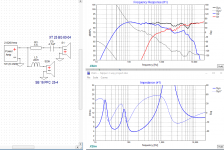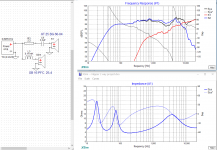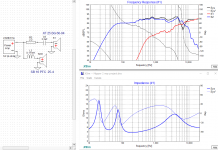I bought a pair of the Dayton BR-1 empty boxes quite some time ago. What have you DIYers done with these? I am going "cheap" at first to just experiment. I will be trying the SB16PFC25-4 6 inch with the Vifa XT25BG60-04 ring tweeter. Has anybody tried this combination of drivers before? I'd like to cross at 4 KHz or higher if possible and I plan on starting with 1st order, 1 coil, 1 cap.; no Zobel. Of course I realize I'll most likely end up "playing around" with different X/O types, slopes, frequencies, etc. BUT; I like to start off as simple as possible. I do prefer 1st order when I can get away with it!
6" SB16PFC25-4 :: SB Acoustics
https://www.parts-express.com/pedocs/specs/264-1012--tymphany-xt25bg60-04-spec-sheet.pdf
Dayton Audio BR-1CAB BR-1 6-1/2" 2-Way Speaker Cabinet Pair
Parts are being shipped now; stay tuned. Let me know if any of you have tried a similar build to the above. Thanks!
6" SB16PFC25-4 :: SB Acoustics
https://www.parts-express.com/pedocs/specs/264-1012--tymphany-xt25bg60-04-spec-sheet.pdf
Dayton Audio BR-1CAB BR-1 6-1/2" 2-Way Speaker Cabinet Pair
Parts are being shipped now; stay tuned. Let me know if any of you have tried a similar build to the above. Thanks!
For a flat baffle TM, the most common crossover uses a BW3 circuit on the tweeter plus a L-pad to match SPL, and a LR2 circuit on the midrange. The difference in phase shift from these circuits helps compensate for the baffle physical offset difference. A ~2kHz crossover would manage the initial SB16PFC25-4 beaming, with good attenuation margin from the 4-5kHz cone breakup. Worth a simulation.
For a flat baffle TM, the most common crossover uses a BW3 circuit on the tweeter plus a L-pad to match SPL, and a LR2 circuit on the midrange. The difference in phase shift from these circuits helps compensate for the baffle physical offset difference. A ~2kHz crossover would manage the initial SB16PFC25-4 beaming, with good attenuation margin from the 4-5kHz cone breakup. Worth a simulation.
I don't worry about beaming at all and I prefer to avoid crossovers in the 2 KHz to 4 KHz range. I really do prefer the results of 1st order when possible. The first thing that I will be concerned with here is the break-up of the SB. What I usually try to do is get the upper most range of the mid/bass as high as possible while avoiding any nasty effects from break-up. When possible; I do this with just a simple inductor. I then add in a parallel resistor if need be to contour the roll-off (similar to BSC techniques but at the higher mid. frequencies). If this doesn't work; I then try a Zobel. Beyond that; I then go to a 2nd order low-pass (if need be). I do this all by ear; as a former musician, based on my personal listening preferences. I realize most designers do NOT go about things this way! Well; anyway, thanks for the suggestions!
I suppose I should add some of my history here. I am a retired Electrical Engineer and Electronics Technician and have been playing around with speaker systems for over 45 years. I do this strictly as a hobby and for the love of music plus needing something to do with my hands and exercising my 61 year old brain! I prefer to experiment and "play around" rather than sticking to the strict science and math. That keeps it fun and interesting for me as a true art form. Obviously; this is NOT what most of you do here! Plus, as a former musician; I use my ears as the final judge; I know what most musical instruments "REALLY" sound like since I played many of them myself!
A virtual and mighty simple project
Passable for a low listening volume and probably as good as it gets with these a few passive components. Crossing higher would produce some weird looking curves but OP is absolutely free to experiment with whatever suits best. Have fun!
Passable for a low listening volume and probably as good as it gets with these a few passive components. Crossing higher would produce some weird looking curves but OP is absolutely free to experiment with whatever suits best. Have fun!
Attachments
.Passable for a low listening volume and probably as good as it gets with these a few passive components. Crossing higher would produce some weird looking curves but OP is absolutely free to experiment with whatever suits best. Have fun!
OK, parts are in! First of all; that nasty looking peak on the SB is really not that nasty at ALL!!! Within the first hour I have already tried many different things. Obviously, the drivers aren't broken in but what I have observed so far:
The Vifa XT tweeter is AMAZING at this price range; no wonder so many people like it! I think it is MORE sensitive than the OEM specs. show.
The SB can also hold it's own but so far; nothing spectacular. However, for the money, right out of the box I'll give it a solid 6 or 7 on a scale of 10 (in this price range. (The tweeter gets a full 9 or 10!).
I tried 0.22 mH on the SB all by itself; the mids sounded too reduced. I then tried straight wired; not bad, just "slightly" ragged but to many people; this could be run full-range! Right now, I'm using 0.11 mH, 14 AWG foil type Jantzen and am quite pleased at the moment.
On the Vifa tweeter so far I tried 5.6 uF; too much output! I then did a series 2.2 Ohm resistor on the tweeter side; still too much. I then went to 3.3 uF with no resistor; still too much. Right now; I have 3.3 uF with the 2.2 Ohm resistor again on the tweeter side. This is a "Sonicap Gen. 1"; the resistor is a "Zister" from Meniscus.
Yes, as I retired EE; I can certainly design just about any crossover, notch, etc. BUT; I really DO prefer to keep it simple; let the drivers "speak" for themselves so to say!
With that tweeter, I would have crossed this one at no more than 1.5kHz myself, especially with that mid.
Interesting design angle on this. I'd be interested in the result if you fiddle until you're happy, then swop out the crossover for a calculated 3rd order.
OK, EVERYONE here is missing the point ENTIRELY! How many musical instruments have you played? The secret is to maintain the entire spectrum of the instruments and voice as best as possible with one driver. I think the best systems I have ever heard over the past 50 years use the widest possible mid or fullrange only supplemented with a woofer below 100 Hz and a tweeter above 10 KHz! If you do NOT have this feeling or experience then you are missing the entire point! I really do NOT care about the simulations or best electronic guesstimates! You have to experience a live, small jazz band or even full symphony orchestra in person THEN, tell me what you "HEAR"!
I traveled with the US Navy doing electronic, acoustic and other high level Engineering and related studies. I worked for Bell Labs! Give me a break guys; the end result should ALWAYS be.....what does it sound like compared to real music!
I traveled with the US Navy doing electronic, acoustic and other high level Engineering and related studies. I worked for Bell Labs! Give me a break guys; the end result should ALWAYS be.....what does it sound like compared to real music!
With that tweeter, I would have crossed this one at no more than 1.5kHz myself, especially with that mid.
Interesting design angle on this. I'd be interested in the result if you fiddle until you're happy, then swop out the crossover for a calculated 3rd order.
Hi and Thanks! Actually; on the tweeter; I have the capacitor BEFORE the resistor! So; if you believe the VIFA specs at 4 Ohms; we than have a tweeter attenuated by about 2 or so dB and then we should calculate the X/O based on about 6.2 Ohms. Not trying to be a smart a#s here guys but I DO know acoustics and electronics VERY well. My point is again...FORGET the damn simulations and pure math for a minute or two. USE your ears and HEARING and not the damn math and science! It is ALL about what sounds natural; complex variables will ALWAYS confound us!...Sermon over for now; it's all about the music after all!
Ok, ok, I get what you are saying. But I find it odd that someone with a technical background wants to ignore the mountain of scientific studies in the audio field on how to design a loudspeaker that sounds as close to live music as possible. A couple of thoughts:
1. You believe "The secret is to maintain the entire spectrum of the instruments and voice as best as possible with one driver". Fine, there's a whole forum here dedicated to full range drivers. But then, why not use a driver designed for that purpose?
2. I have no problem if you want to play around and do your own thing. So why bother posting at all? You asked what people thought and they simply responded.
By the way: I have played several instruments, toured Europe as part of a concert band, regularly attend live jazz/concert/symphony concerts and am a retired EE.
1. You believe "The secret is to maintain the entire spectrum of the instruments and voice as best as possible with one driver". Fine, there's a whole forum here dedicated to full range drivers. But then, why not use a driver designed for that purpose?
2. I have no problem if you want to play around and do your own thing. So why bother posting at all? You asked what people thought and they simply responded.
By the way: I have played several instruments, toured Europe as part of a concert band, regularly attend live jazz/concert/symphony concerts and am a retired EE.
Last edited:
Ok, ok, I get what you are saying. But I find it odd that someone with a technical background wants to ignore the mountain of scientific studies in the audio field on how to design a loudspeaker that sounds as close to live music as possible. A couple of thoughts:
1. You believe "The secret is to maintain the entire spectrum of the instruments and voice as best as possible with one driver". Fine, there's a whole forum here dedicated to full range drivers. But then, why not use a driver designed for that purpose?
2. I have no problem if you want to play around and do your own thing. So why bother posting at all? You asked what people thought and they simply responded.
By the way: I have played several instruments, toured Europe as part of a concert band, regularly attend live jazz/concert/symphony concerts and am a retired EE.
Hi, actually we are thinking alike! I have MANY designs; expensive, not and in between. My current "reference" system is; in fact, a full-range with woofer below 100 Hz and a tweeter above 10 KHz. I was trying to find out, within this post, if anyone had tried these "exact" drivers. The goal here was to get a cheap 2-way with a minimum amount of effort that still sounded "good". Well, this does exactly that! I usually listen to small ensemble jazz and Baroque chamber music but I do also listen to full symphony orchestra and even classic rock. What I want to know from the DIY community is what do your experiences tell you with certain drivers and designs. I am NOT asking for people to design anything for me; rather, give me your experiences with different drivers and designs; how do they "sound"??? SO, the point again is what does something sound like as compared to what math or simulations can you run for me. The end result is, of course, is the "end user" happy with the "sound quality"? I worked at Bell Labs; I don't care about the math, science or simulations at my retired age; I care about the end result at "ANY" price range sounding like "music".
It would be COOL if you measured your speaker both on-axis and off-axis.
Hi guys. again; NOT trying to be a smart a*s here; just doing my hobby and music "my way". SO, I don't have any calibrated microphone, test equipment or anything other than a few test CD's and my own 2 ears. I DID run some test CD tones and some free, downloadable test tones, sweeps, etc. from my laptop. The nasty looking peak around 4 to 5 KHz showing on the SB 16*** OEM FR SPL plot is NOT anything overly annoying! I could barely detect it; many other drivers OEM plots that "appear" smoother are way far from it!
I think based on the time, energy and effort; these have got to be the best sounding "cheap" speakers I have ever done in over 45 years of playing around! Total time to "fine tune" the current X/O was less than 10 minutes! Of course, Break-in is still going on.
In summary; I have a 0.11 mH inductor on the SB 16*** (no Zobel, etc; just a simple coil in series!). This is a Jantzen 14 AWG copper foil inductor I already had on hand. On the Vifa XT tweeter; I have a 3.3 uF cap. ahead of 2.2 Ohms in series (assuming 4 Ohms on the tweeter; this gives us an attenuation in the ball park of 2 to 3 or so dB with the 3.3 uF capacitor "seeing" about 6.2 Ohms.). Again; the cap is a "Sonicap" Gen. 1; the resistor is a "Zister". (I have a lot of X/O and resistor parts on hand already from previous "experiments".) If I had to guess; this is fairly flat in room from about mid 40's to over 15K (+/- 3 dB). I'm getting the lowest piano tones (ie 27.5 Hz to well beyond my hearing range [above 10 KHz] without any OBVIOUS peaks, dips or harshness what-so-ever!). PM if you want more EXACT details! happy listening, best regards!
Based on my handi-dandi calculator; the tweeter should be -3 dB around 7800 Hz and -6 dB around 4500 Hz (taking into account the 2.2 Ohm series resistor). And, we of course have the attenuation here as well. When I was doing test tones; the SB16*** still had fairly "flat" output out beyond what the OEM FR shows. At 8 KHz the level was way down. When I was still working; I had access to all kinds of laboratory grade test equipment and I did have a calibrated microphone at one time. It would be nice to be able to measure this cheap 2-way accurately but I'm not going to do that. I was hoping some of you guys had already tried these drivers, especially the SB.
SB's are starting to break-in nicely now. I have gone back and tried different inductors again - now: 0.22, 0.18, 0.14 and 0.11 mH. The 0.11 mH still sounds better than the higher values but NOW; I am running the SB straight again (NO X/O at all on the mid-bass) while keeping the tweeter circuit as it was for now. While far from perfect; this is a really good sounding project and I will continue to play around with it. I guess the point I'm trying make here is that if the drivers are capable; keep the X/O design at the very BARE minimum! I am using Diana Krall right now as my base-line "reference" since, in my opinion, female singing voice and piano are the hardest to record and reproduce accurately. Again, sorry if I'm coming off as being too strong, not trying to be an a*s but really feel way too many people are caught up in the "correctness" in theory, etc. instead of just "listening" to music while "fine-tuning" CHEERS and REGARDS!
It's been a few days now more of break-in. I have put the 0.11 mH inductor back on the SB after playing around even more with straight wire and other inductors. I tried a few different capacitor values on the tweeter as well. Right now; the tweeter has a 3.3 uF in parallel with 0.47 uf (total about 3.8 uF). 4.3 uF and 5.6 uF put the tweeter too low for what I'm trying to do here. The 0.11 mH seems to be the best overall as there is some ragedness or roughness when running the SB straight (although NOT really bad). Adding the extra 0.47 uF on the tweeter helped balance out the small loss of extra treble from the SB (doing to no longer being straight wired). Again; Diana Krall is my base-line. I have found when her voice and piano are "just right"; almost every recording I own are also "just right". I really don't expect most of you to agree with my methods and that's OK! Again; I prefer to let the drivers do the work to the extent possible with an absolute minimum of X/O parts. OBVIOUSLY, this is a personal taste kind of thing; sort of like art. Whatever floats your boat and frosts your cookies!
- Status
- This old topic is closed. If you want to reopen this topic, contact a moderator using the "Report Post" button.
- Home
- Loudspeakers
- Multi-Way
- Small, Cheap 2-Way with BR-1 Box


